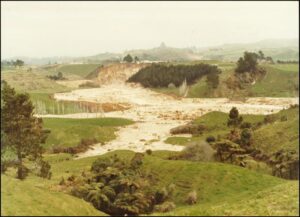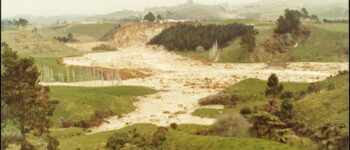1981: Ruahihi Disaster
September 19, 2024
By AHNZ

Today in New Zealand history, 19 September, 1981, the Ruahihi Power Station was officially opened by Prime Minister Robert Muldoon. It was part of National 3.0 era Think Big program and had coast $27 million. “Rumour is that they had overfilled the canal for the opening to look impressive for Muldons opening..” Ref. Comment to AHNZ (2024)
The following day, 20 September, the canal feeding the station collapsed and destroyed itself. Rapidly belching vast quantities of rubble, silt, mud, and boulders spread over surrounding property. The scheme had been operating since March that year. A ticking time bomb.
A photo of Muldoon clipping the ribbon to this disaster waiting to happen on that historic occasion would be marvelous. The local MP Keith Allen (National) was surely also there but unlike his leader could not flit away from the scene of his angry constituents. The stress and guilt must have contributed (along with diabetes, vodka, and broken marriage,…) to Allen’s political burnout and early death on 21 July, 1984. His vacant seat was then taken up by Winston Peters.
The power station was badly damaged as were surrounding areas. It was costly and destructive in the short term to roads, power lines, and farmland. In the mid-term it was patched up and the station working again with pipelines instead.
“1.50 p.m. on Sunday 20 September 1981, one day after Ruahihi Power Station had been officially opened, the eastern bank of the canal supplying water to the Ruahihi Power Station collapsed. Up to one and a half million cubic metres of liquid mud and rubble descended down the valley of Ivy Creek, across State Highway 29, and into the Wairoa River. A 600-metre-long stretch of canal was destroyed, and a section of the highway was washed out.” – Tauranga Heritage Collection, Tauranga City Council
“…a massive slope failure during which a chasm 500 m long, 100 m wide and 40 m deep was gouged out in about one hour. There was no loss of life and no-one was injured. The cause of the failure has been attributed to the behaviour of the volcanic soils when wetted and loaded by the canal water materials….Early investigations indicated the nature of the materials, but the significance of these was apparently
not recognised in the planning, detailed investigation and design stages.” – Oborn report (1988)
“This silting is probably more the result of the most catastrophic event at Wairoa since Crown-sponsored development began on the river, the collapse of the Ruahihi canal in 1981. The collapse of the canal, used to divert water to the ‘Think-Big’ era Ruahihi hydroelectric development, sent a flash flood of mud and debris including boulders weighing several tonnes, down the Wairoa River. A report prepared in the wake of the disaster for the Ministry of Public Works by the Hamilton Science Centre, showed conclusively that the Wairoa was not flushing this mass of sediment out into the Tauranga Harbour as originally envisaged. Rather the majority of this massive volume of mud was now resting on the riverbed in the lower reaches of the Wairoa.” – L Rooi report (1999;) Ministry of Justice
“Mr Muldoon noted, he had [only just] “driven across the top of that thing…Apres moi, le deluge.” – Press (23 September, 1981,) Papers Past
“Allen was burned out by diabetes and politics. Muldoon ought to have let him go but instead rode his trusty lieutenant into the grave.” – 1984: Death of Keith Allen, AHNZ
 Residents had been trying to warn the government of the impending danger but were not being heeded.
Residents had been trying to warn the government of the impending danger but were not being heeded.
Local man Jim Ewart told reporters that local residents had feared that something might happen after cracks had appeared beside the canal earlier this year. Residents had been meeting up and predicting the event and came close to making a protest march during the opening earlier in the year. “Ruahihi residents, had publicly voiced their fears about the canal’s safety for some time but had received a generally unsympathetic response” Ref. P.M. rejects call for canal inquiry, Press (1981)
Muldoon was a busy Prime Minister and wasn’t going to let a little speed bump like the Ruahihi Disaster slow him down. He had just attended the South Pacific Forum and already off to CHOGM (Commonwealth Heads of Government Meeting) in Melbourne during September 1981. The PM was “in battle order” and bashing out international political deals with world leaders. There trade imbalance and the Oil Shocks to navigate for the sake of the nation’s survival. What’s was a little setback in a backwater like Hawke’s Bay to a great man? Ref. His Way- Robert Muldoon, Barry Gustafson (2012)
On 28 September 1981 Muldoon’s cabinet approved the construction of the Aramoana smelter. This put them up against locals who could not have failed to observe the collateral damage inflicted by Think Big and resisted successfully. “By the end of 1981 the Big Think was out of Thinks. Muldoon’s lot could not make the deal work. Aramoana’s work done, it quietly and peacefully reunified with New Zealand.” Ref. 1980: The Independent State of Aramoana, AHNZ
A similar earth canal collapsed on 30 December, 1982, but this time it was a disaster for Rotorua’s Wheao Power Station. Muldoon’s rip/shit/bust projects had begun to pile up. The 1984 Snap Election did not save him. Labour 4.0 was elected.
Without the government who would give the people electricity and keep them safe from flood waters?
—
Image ref. Ruahihi Power Station disaster (1981,) Tauranga Heritage Collection, Tauranga City Council
Image ref. ‘Protect your future’ campaigning slide, Screens Advertising Limited; Tauranga Heritage Collection, Tauranga City Council
 Like Comment Share
Like Comment Share





